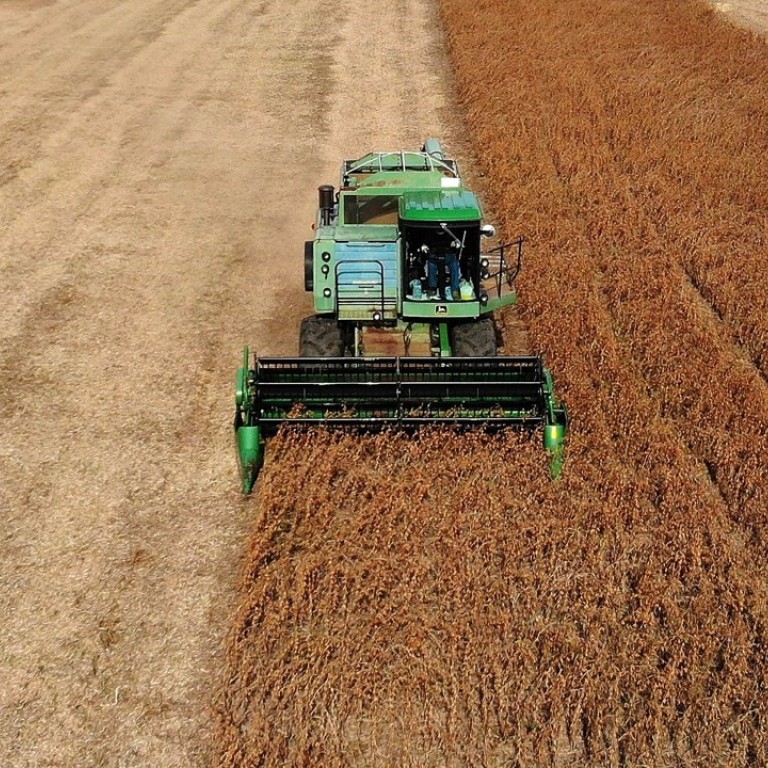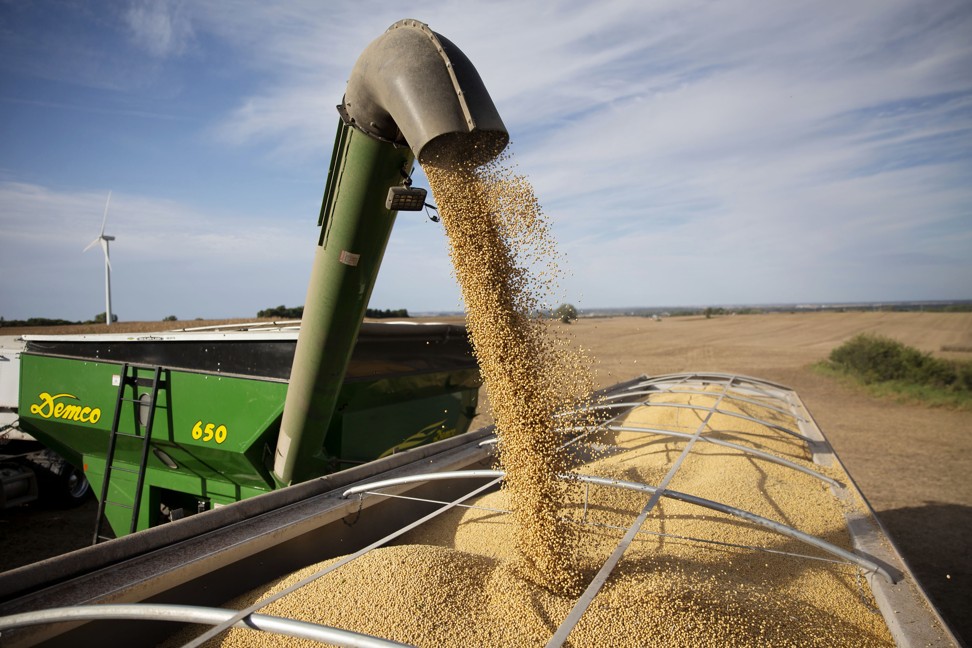
Exclusive | In 2012, this Iowa man hosted Xi Jinping. Now Donald Trump’s trade war is hurting his soybean farm
- By June, when Trump’s tariffs elicited a tit-for-tat response from China, US exports of soybeans to its largest market had fallen to 500,000 tonnes
- In November, China’s imports plunged 38 per cent from a year ago to lowest monthly level in two years
On an autumn morning in November, Grant Kimberley told a room full of visitors how income from his 4,000-acre (1,600 hectares) family farm in Maxwell, Iowa, has plummeted by as much as 25 per cent in a year, because of the trade war that his president has started with his largest export market.
“Soybeans and agriculture have become the collateral damage” in America’s relations with its biggest trading partner, Kimberley said, flicking between PowerPoint charts that showed the plunging sales of soybeans and their prices. “Soybean exports to China have fallen by more than 90 per cent, and the price is at a 12-year low.”
But Kimberly, 42, is no ordinary Iowan soybean farmer. His family hosted Xi Jinping in 2012, just a few months before the then Chinese vice-president was promoted to become the head of state of the world’s most populous nation.
Kimberley’s father Rick was named honorary dean of an agricultural college in western China’s Shaanxi province, while the family home has been replicated as a show farm in an agritourism park in Hebei’s provincial capital of Shijiazhuang, near Beijing.

The Kimberleys’ story illustrates how the US-China trade war has upended decades of relations between the two nations, not to mention the US$700 billion of bilateral commerce between the two largest economies on the planet.
China consumes 63 million tonnes of soybeans every year, using the crop mostly for crushing into cooking oil, blending into tofu and milk, and for making feed for livestock. Chinese farmers produce a combined 14 million tonnes of the crop every year, having to import the remainder from the US, Brazil and Russia.
The current US-China trade war is no different. China’s monthly imports of US soybeans fell from a little over 6 million tonnes in December 2017 to less than 1 million tonnes in May, as US President Donald Trump escalated his rhetoric to close his nation’s trade deficit with China.
By the time Trump announced his 25 per cent tariffs on US$50 billion of Chinese goods – which prompted a tit-for-tat retaliation by China 48 hours later – in June, Chinese imports of American soybeans had fallen to 500,000 tonnes.
In November, China’s soybean imports plunged 38 per cent from a year ago, hitting the lowest monthly number in two years, according to Reuters, as the world’s largest buyer of the crop continued to avoid US shipments.
The trouble for the Kimberleys and the 86,900 Iowan farmers – the second-biggest soybean-producing US state after Illinois – began as the trade war escalated.
The Chinese authorities, led by former finance minister Lou Jiwei, were selective in their tariffs, hitting at US farmers who could be decisive in a potential re-election bid by Trump, or the US midterm elections.
Even though Iowa is considered one of the key battlegrounds in US politics, the Hawkeye State has voted for Democrats in six of the seven presidential elections from 1992 through 2012.
It all changed in 2016, when Trump won the state with a 15-point swing from Barack Obama’s 2012 victory. That was the largest margin of any Republican since Ronald Reagan carried the state in 1980. Iowa is so important to the Republican Party that the current US Ambassador China Terry Branstad is a born-and-bred Iowan, and a former state governor for an unprecedented six terms.
In the midterm elections last month, Iowa flipped two congressional seats to the Democrats, while the Republicans held on to the governor’s mansion.

To be sure, the reason behind the swing were far more complicated than the ongoing trade war with China, said the Des Moines Register’s business editor Rami Grunbaum.
“There are other issues that matter a lot, like the health care system,” she said in a recent interview in the state capital.
Many Iowan farmers say they are still leaning red, even if they are in the frontline bearing the brunt of China’s retaliatory tariffs against America.
“I don’t think it’s Trump’s fault that agriculture is doing badly,” said Brock Hanson, who owns a 2,000-acre soybean and corn farm in Baxter, Iowa, speaking during a visit in November. “Farming has been down for the last four or five years.”
Hanson has sold only 30 per cent of his 2018 harvest, due to plunging demand by China, making this crop year his worst in two decades of tilling the land. Last year, he was able to pre-sell more than half his crop even before he started his harvester machine.
“The only comparable experience may be during the recession of the 1980s, when my father could barely survive,” Hanson said. “His advice for me was to spend wisely; we have to suffer before things get any better.”
Soybean seeds travelled to the Americas during the 18th and 19th centuries through early emigrants and workers in Chinatown. The crop took off in the US after the Second World War.

Chinese farmers are trying to plant more of the crop, going to extraordinary lengths to catch up. Seven Chinese citizens were accused in 2013 of trying to steal American soybean seeds from Iowan farms to send back to China.
Mo Hailong, one of the seven, who was a US permanent resident, was sentenced to 36 months in jail, after he admitted to stealing the trade secrets of DuPont Pioneer and Monsanto.
“China is also playing hard ball,” said the Iowa Farm Bureau Federation’s president Craig Hill. “Intellectual property is a deep concern for everybody. If not Trump, who else” could address the issues with China, he asked.

Over grilled steak and a Cabernet Malbec in Buenos Aires, Xi and Trump agreed on December 1 to a ceasefire in their trade war, hatching out a plan to work out their trade issues over 90 days.
According to the White House, negotiation would be focused on structural changes in forced technology transfer, intellectual property protection, non-tariff barriers, cyber intrusions and cyber theft, services and agriculture.
“China is now an issue for the US presidential election,” said Derek Scissors, a China expert at the American Enterprise Institute who consults with the White House. “By 2020, the Democrats would attack Trump for being soft on China, and not being too provocative. The president will be under very heavy political pressure to take stronger actions against China.”
The prospects for real progress on substantive issues with China “are now better than at any point in the Trump administration”, as the change in the tone and direction of the bilateral conversation is very important and is likely to provide a short-term boost to business confidence in both countries, said Matthews Asia’s investment strategist Andy Rothman.
The Chinese government has bought up to 2 million tonnes of US soybeans this week, Bloomberg reported, citing the US Soybean Export Council, the first import by China since the truce was declared on December 1. China could buy between 5 million tonnes and 8 million tonnes of US crop.
“Hopefully, more of that will be coming in the near future,” Kimberley said by email. “Hopefully the purchases will grow even larger than what has been reported, and more than what they were in the previous years.”


